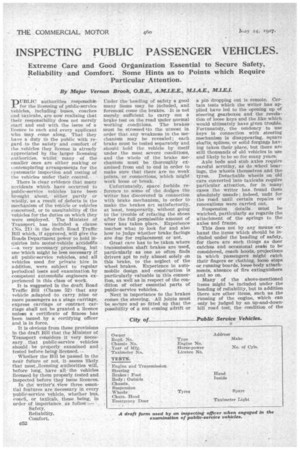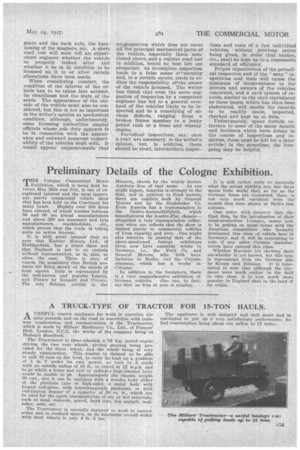INSPECTING PUBLIC PASSENGER VEHICLES.
Page 110

Page 111

If you've noticed an error in this article please click here to report it so we can fix it.
Extreme Care and Good Organization Essential to Secure Safety, Reliability and Comfort. Some Hints as to Points which Require Particular Attention.
By Major Vernon Brook, 0.B.E., A.M.I.E.E., M.I.A.E., M.I.E.I.
PUBLIC authorities responsiblie for the licensing of public-service vehicles, including buses, coaches and taxicabs, are now realizing that their responsibility does not merely start and end with the issue of a licence to each and every applicant who may come along. That they have a duty to the public with regard to the safety and comfort of the vehicles they license is already appreciated by the larger licensing authorities, whilst many of the smaller ones are either making or contemplating arrangemertts for the systematic inspection and testing of the vehicles under their control.
There is clear evidence that many accidents which have occurred to public-service vehicles have been brought about, either partly or wholly, as a result of defects in the mechanism of the vehicle or vehicles concerned, or to unsuitability of the vehicles for the duties on which they were employed. The Minister of Transport has included a clause (No. 21) in the draft Road Traffic Bill which, if approved, will give the Roads Department power to hold inquiries into motor-vehicle accideffts —a very necessary proceeding, but one which might be less necessary if all public-service vehicles, and all vehicles used for private hire in addition, were subject to• regular periodical tests and examination by competent automobile engineers experienced in this class of work.
It is suggested in the draft Road Traffic Bill (Clause 52) that any vehicle adapted to carry 'nine or more passengers as a stage carriage, express carriage or contract carriage shall not be granted a licence nnlees a certificate of fitness has been issued by a certifying officer and is in force.
It is obvious from these provisions In the draft Bill that the Minister of Transport considers it very necessary that public-service vehicles should be properly examined and tested beforeheing licensed.
• Whether the Bill be passed in the near future or not, it-Seems likely that most.liceiasing authorities will, before long, have all the vehicles licensed by them properly tested and inspected before they issue licences. in the writer's view three essential features are necessary in every public-service vehicle, whether bus, coach, or, taxicab, these being, in order of importance. as follow :— Safety.
Under the heading of safety a good many items may be included, and foremost come the brakes. -It is not merely sufficient to carry out a -brake test on the road under normal working conditions. The brakes must be stressed !to the utmost in order that any weakness in the mechanism may be revealed ; each brake must be tested separately and should hold the vehicle by itself under the most severe conditions, and the whole of the brake mechanism must be thoroughly examined from end to end in order to make sure that there are no weak points, or connections, which might work loose or break.
Unfortunately, space forbids reference to some of the dodges the writer has discovered in connection with brake mechanism, in order to make the brakes act satisfactorily, at least, temporarily, without going to the trouble of refacing the shoes after the full permissible amount of wear has taken place. Experience teaches what to look for and also how to judge whether brake facings are due for replacement or not.
Great care has to be taken where transmission shaft brakes are used, particularly as one so often finds drivers apt to rely almost solely on this brake, to the neglect of the wheel brakes. Experience in automobile design and construction is particularly valuable in this connection, as well as in respect of the condition of other essential parts of public-service vehicles.
Next in importance to the brakes comes the steering. All joints must be, secure and so fitted up that the possibility of a nut coming adrift or a pin dropping out is remote. Certain tests which the writer has applied have led to the opening up of steering gearboxes and the revelation of loose keys and the like which would ultimately have given trouble. Fortunately, the tendency to use keys in connection with steering mechanism is disappearing, square shafts, splines, or solid forgings havMg taken their place, but there are still thousands of old vehicles in use and likely to be so for many years.
Axle beds and stub axles require careful scrutiny, as do .wheel bearings, the wheels themselves and the tyres. Detachable wheels on old cars converted into taxicabs require particular attention, for in many cases the writer has found them absolutely unsafe; indeed, unfit for the road until certain repairs or renovations were carried out.
Suspension details must be watched, particularly as regards the attachment of the springs to the axles and frame.
This does not by any means exhaust the items which should be included under the heading of safety, for there are such things as door catches and occasional seals to be considered, coach hoods, projections in which passengers might catch their fingers or clothing, loose steps or running boards, loose body attachments, absence of fire extinguishers and so on.
Many of the above-mentioned items might be included under the heading of reliability, but in addition there are other items, such -as the running of the engine, which can only be judged by an up-and-downhill road test, the condition of the gears and the back axle, the functioning of the magneto, etc. A-short road test will soon tell an experienced engineer whether the vehicle be properly looked after and whether it be in fit condition to be licensed as it is or after certain alterations have been made.
When considering comfort, the condition of the interior of the vehicle has to be taken into account, its cleanliness and the State of the seats. The appearance of the outside of the vehicle must also be considered, but this is not so important in the writer's opinion as mechanical condition, although, unfortunately, some licensing authorities employ officials whose sole duty appears to be in connection with the appearance and outward apparent respectability of the vehicles dealt with. It would appear unquestionable that
an inspection which does not cover all the principal mechanical parts of the vehicle, especially those mentioned above, and a regular road test in addition' would be best left out altogether. An incomplete inspection leads to a false sense of*security and, to a certain extent, tends to reduce the responsibility ofcthe owner of the vehicle licensed. The writer has found that even the mere suggestion of inspection by a competent engineer has led to a general overhaul of the vehicles likely to be inspected and to a remedying of obvious defects, ranging from a broken frame member to a leaky petrol tank or a loose and wheezy engine.
Periodical inspections, say, once a year, are necessary, in the writer's opinion, but, in addition, there should be short, intermediate inspec
tions and tests of a few individual vehicles, without previous notice being given, in order that brakes, etc., shall be kept up to a reasonable standard _of efficiency.
Proper organization of the periodical inspection and of the " snap " inspections and tests will cause the minimum of inconvenience to the drivers and owners of the vehicles concerned, and a card system of records, similar to the card reproduced on these pages, which has since been elaborated, will enable the records to be readily made, inspected, checked and kept up to date.
Unfortunately, space forbids reference to some of the many details and incidents which have arisen in the course of inspections and inquiries, these must be left for a later article; in the meantime, the foregoing may be helpful.




















































































































































































